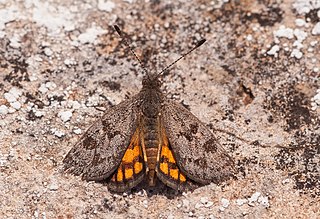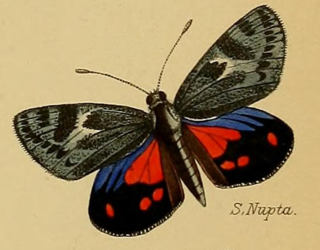
Castniidae, or castniid moths, is a small family of moths with fewer than 200 species: The majority are Neotropical with some in Australia and a few in south-east Asia. These are medium-sized to very large moths, usually with drab, cryptically-marked forewings and brightly coloured hindwings. They have clubbed antennae and are day flying, and are often mistaken for butterflies. Indeed, some previous classification systems placed this family within the butterflies or skippers. The Neotropical species are commonly known as giant butterfly-moths, the Australian and Asian species as sun moths. The larvae are internal feeders, often on roots of epiphytes or on monocotyledons.

Synemon plana, commonly known as the golden sun moth, is a diurnal moth native to Australia and throughout its range, it is currently classified as vulnerable under the Environment Protection and Biodiversity Conservation Act 1999.

Synemon is a genus of moths within the family Castniidae. It was described by Edward Doubleday in 1846. The genus contains 24 described and 20 undescribed species.

Synemon theresa, the cryptic sun moth, is a moth in the Castniidae family. It is found in Australia, including South Australia and Victoria.

Synemon discalis, the small orange-spotted sun-moth, is a moth in the Castniidae family. It is found in Australia, including South Australia, Western Australia and Victoria.
Synemon jcaria, the reddish-orange sun-moth, is a moth in the Castniidae family. It is found in Australia, including Victoria.
Synemon nais, the orange sun-moth, is a moth in the Castniidae family. It is found in Australia, including Victoria, South Australia and south-eastern Western Australia.
Synemon collecta, the striated sun moth, is a moth in the family Castniidae. The species was first described by Charles Swinhoe in 1892. It is found in Australia, including Victoria, New South Wales and Queensland. The population in Victoria might represent an undescribed allied species.

Synemon parthenoides, the orange-spotted sunmoth or link moth, is a moth in the Castniidae family. It is found in Australia, including Victoria, Western Australia and South Australia.
Synemon selene, the pale sun-moth, is a moth in the Castniidae family. It is found in Australia, including Victoria and South Australia.
Synemon leucospila, the yellow-spotted sun moth, is a moth in the Castniidae family. It is found in Australia, including Western Australia.
Synemon heliopis is a moth in the Castniidae family. It is found in Australia, including Western Australia.

Synemon catocaloides is a moth in the Castniidae family. It is found in Australia, including northern Western Australia.

Synemon gratiosa, the graceful sun-moth, is a moth in the Castniidae family. It is found in Western Australia, from Namburg National Park in the north to Mandurah in the south.
Synemon magnifica, the magnificent sun-moth, is a moth in the Castniidae family. It is found in Australia, including New South Wales.
Synemon maja is a moth in the Castniidae family. It is found in Australia, including Western Australia.

Synemon notha is a moth in the Castniidae family. It is found in Australia, including Western Australia.

Synemon nupta is a moth in the Castniidae family. It is found in Australia, including Western Australia.
Synemon phaeoptila is a moth in the Castniidae family. It is found in Australia, including the Northern Territory and Queensland.









